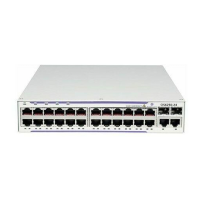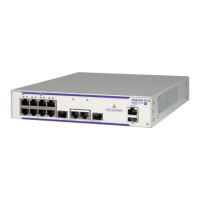System Intialization
Page 110 7210 SAS D, E, K OS Basic System Configuration Guide
System Intialization
Note: Some 7210 SAS platforms (For example: 7210 SAS-K) do not ship with an image. It is
expected that the user will use the external flash or the USB device with bootloader image
(boot.tim) to boot the system. The user will need to insert the device (either the compact flash into
the external compact flash slot or the USB storage device into the USB port) before powering on
the system. For more information on the pre-requisites, please check the 7210 SAS Installation
guide to know how to install the image and boot the system.
When the system is powered ON, it executes the bootstrap image, for example, the boot.tim file,
from the file system which is located on a non-removale flash device (cf1:) or the USB (on 7210
SAS-K) that is built in to the 7210 SAS-Series router. The boot.tim file is the image that reads and
executes the system initialization commands configured in the Boot Option File (BOF). The
default behavior is to initially search for the boot.tim file on cf1:. This behavior cannot be
modified.
If the boot.tim file is not present, or is not a valid file that can be loaded, the Golden bootstrap
image is loaded by the bootrom on 7210 SAS-E/D. The Golden bootstrap image is equivalent to a
boot.tim file except that it is present outside the file system and can be updated and checked by
means of special CLI commands. On 7210 SAS-K, if the boot.tim is not found in the default
location (cf:\boot.tim), the software searches for the boot.tim at other storage locations (such as
uf1:\) and will use the boot.tim located there to boot the system.
When the system executes boot.tim, provision is given to the user to modify the BOF manually
and save it or to boot using existing BOF. The bootstrap image then processes the BOF file present
in the flash as explained in Configuration and Image Loading on page 118.
When the system executes boot.tim, provision is given to the user to modify the BOF manually
and save it or to boot using existing BOF. The bootstrap image then processes the BOF file present
in the flash as explained in Configuration and Image Loading on page 118.
On systems that are shipped without a BOF file, when the system is powered ON for the first time,
there will be no BOF in the system. Therefore, provisions are given to create a new BOF file or
alternatively get the BOF file from the network. There are two options:
• Boot by manually creating a BOF file (manual boot).
• Boot by retrieving the BOF file from the network, using DHCP to get the network location
of the BOF file (auto init). Auto-init is the default boot procedure if there is no manual-
intervention during the first-time boot of the node.
More details on how to use the various system boot options is available in the platform Installation
guide.

